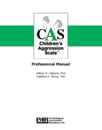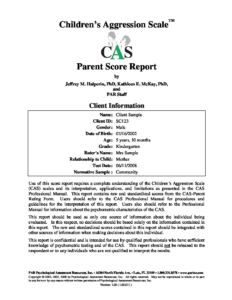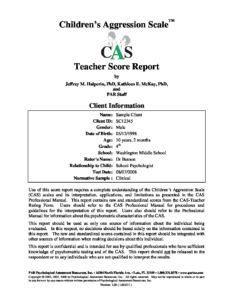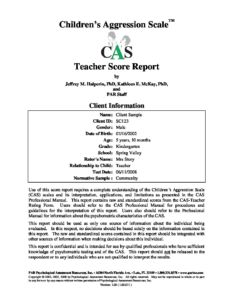
Childrens Aggression Scale cas-childrens
For: Evaluate frequency and severity of child and adolescent aggression
Reading Level: Child - Adolescent
Format: Paper-and-Pencil
Length: 10-15 minutes
Scoring: Hand Scored
Printed Forms & Handscoring Materials
Test forms, response booklets and scoring reference manuals.
CAS Parent Rating Forms (25) (Childrens)
CAS Parent Score Summary Forms/Profiles (25) (Childrens)
CAS Teacher Rating Forms (25) (Childrens)
CAS Teacher Score Summary Forms/Profiles (25) (Childrens)
Authors
Jeffrey M. Halperin, PhD and Kathleen E. McKay, PhD
Description
The prevalence of aggression among youth continues to increase at an alarming rate. With youth violence accounting for 1 in every 12 murders that occurred in the U.S. in 2002 (Snyder & Sickmund, 2006), and 33% of U.S. high school students in 2003 reporting involvement in one or more physical fights within the past year and 12.8% reporting being in a physical fight on school property (Centers for Disease Control and Prevention, 2004), the need to assess and treat aggressive behaviours has never been greater.
The CAS is an informant rating scale that is designed to evaluate setting-specific frequency and severity of aggressive acts of children and adolescents ages 5-18 years. Distinct from other more common measures that address oppositional defiant and antisocial behaviours, the CAS examines the aggressive acts of these youth.
Items describe actual acts of aggression versus a wide variety of behaviours that are associated with disruptive behaviours, which in turn facilitates the establishment of treatment planning and treatment monitoring.
Features of the CAS
Uses a multiple informant approach – The CAS has a Parent Rating Form and a Teacher Rating Form that provides the examiner with information about setting-specific (i.e. home and school, respectively) aggressive acts.
Assesses the severity and frequency of aggressive behaviours – The CAS captures information about both areas, whereas other measures assess only the presence or absence of an aggressive behaviour. In addition, CAS items are weighted differentially, depending on the severity of the act. This methodology allows for more severe acts of aggression to be weighted more heavily than less severe acts of aggression.
Items describe actual acts of aggression versus disruptive behaviours – Both the Parent Rating Form and the Teacher Rating Form include the following scales: Verbal Aggression, Aggression Against Objects and Animals, Physical Aggression and Use of Weapons. Clusters for both forms include Provoked Physical Aggression, Initiated Physical Aggression, Aggression Toward Peers and Aggression Toward Adults. The Parent Rating Form has two additional clusters: Aggression Against Family Members and Aggression Against Non-Family Members. Both forms also include the total score – the Total Aggression Index.
Applicable in a variety of settings – The CAS may be used as an assessment tool and as a tool to assist in treatment planning and treatment monitoring. It may be used in clinical settings, in educational settings, and in forensic/criminal justice settings. The CAS may also be used in research settings for screening participants (i.e., inclusion/exclusion criteria), as the dependent measure, or as an independent or predictor variable.
Standardisation, Reliability, and Validity
The CAS was standardised on a community sample of 438 parents and 516 teachers of children ages 5-18 years that was well-matched to U.S. population parameters for age and gender. In addition to the community sample, data was collected on a clinical sample of 247 parents and 252 teachers of children ages 5-18 years of age. Four specific clinical groups make up the clinical sample: (a) ADHD, (b) oppositional defiant disorder (ODD), (c) conduct disorder (CD), and (d) social maladjustment (SM).
Reliability – Internal consistency coefficients for the scales and Total Aggression Index ranged from .63 to .83 for the CAS-Parent Community sample and .72 to .94 for the CAS-Parent Clinical sample. Similar results were obtained for the scales and Total Aggression Index of the Teacher Form, with internal consistency coefficients ranging from .58 to .89 for the Community sample and .72 to .94 for the Clinical sample. Test-retest stability for the CAS scales, clusters and index ranged from .69 to .99 and .84 to .99 for the Parent Form and the Teacher Form, respectively. Good inter-rater reliability coefficients were obtained with median reliabilities of .87 and .97 for the Parent-Parent and the Parent-Teacher samples, respectively.
Validity – Validity for the CAS was examined in terms of inter-correlations among the scales and clusters, convergent validity with existing behavioural measures (i.e. BASC-2, CBCL) and domain-specific assessments (i.e. OAS, CDS, IOWA Conners), and clinical validity among varying clinical samples (i.e., ADHD, ODD, CD, SM).
CAS Components
The CAS consists of the Professional Manual, the carbonless Parent Rating Form, the carbonless Teacher Rating Form, the Parent Score Summary Form/Profile, and the Teacher Score Summary Form/Profile.
The Professional Manual contains administration and scoring information, normative tables, and reliability and validity information, along with four case studies.
NB: Prices are in Australian dollars inclusive of GST. NZ customers need to log in to view ex-GST prices.






